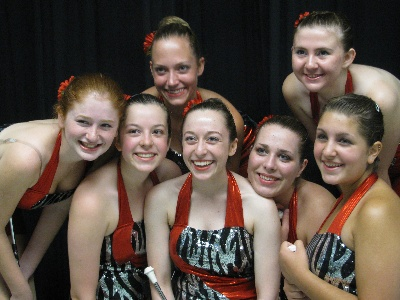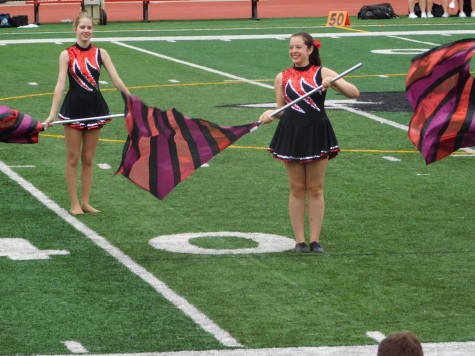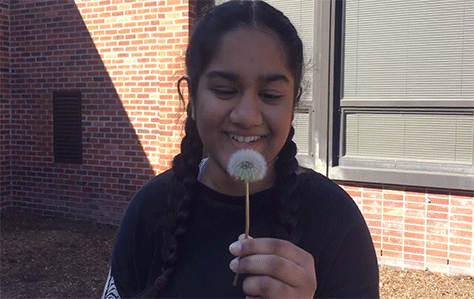The girl who twirls

Photo Credit: Rosengren Family
A team photo with Mandy and her sister, Nikki.
April 26, 2016
“Girls ready?” the judge asks the five girls wearing black leotard dresses. The girls stand in the center of an open gym, watched by groups of people in the audience. Mandy Rosengren, one of the baton twirlers, was feeling slightly nervous as she waited for the silence to fill. She could feel the butterflies floating around in her stomach. “Music!” the judge commands and My Dear Friend by Ivy Levan starts to play. Immediately, the girls come to life and start to snap. As one unit, the baton twirlers move across the gym stretching out their limbs and moving into different formations. Mandy’s nervousness starts to diminish as she listens to music and as she throws her baton in the air the crowd cheers her on.

Illumination Twirlers pose for a picture after winning trophies for a competition.
Rosengren is a senior who is both an accomplished baton twirler and a member of the color guard. At just the young age of four, she followed in her sister’s footsteps and became interested in baton twirling. Because she was so young, there was no team that she could join but the older she got, the more opportunities she had to grow as a twirler. One of her favorite teams was one that she was a part of when she was in eighth grade. While she was a part of that team, she performed alongside her sister. Now, Rosengren is on one of the most competitive baton twirling team, the Illumination Twirlers. The four other girls currently on Illumination Twirlers, Katie, Patricia, Courtney and Gena, are all younger than Rosengren but all five girls are just as close as a family.
This competition that the girls recently competed in was the first of the year. Similar to the past competitions that the team has competed at, the girls had to stay at the gym where they would perform for the entire day. In most baton twirling competitions there are different categories to compete in. Rosengren has competed in solo, two baton, three baton, duet, show twirt, strut and team competitions in her years of baton twirling. Although the competitions are competitive, many of the other teams are kind to each other, lending batons if other baton twirlers forget them. At one competition, Rosengren forgot to pack her shoes during the rush of getting ready. Before she was about to perform she realized what was missing but luckily a baton twirler from the other team lent her shoes. Opposing teams will even cheer each other on during the different competitions.
As Illumination Twirlers perform on the floor of a school gymnasium, they are cheered on by the people in the stands. The crowd consists of the twirlers’ parents and friends. In basic competitions, the audience is relatively smaller but when the competitions reach the regional or national level, so many people come to show their support that the bleachers have to be pulled out. Most basic competitions are held in Bloomsfield, NJ or Rahway, NJ whereas regionals are held in Kutztown, PA.
Rosengren’s favorite competition was during her sophomore year where she performed on her birthday. Before she performed with the rest of her team, the judge wished her a happy birthday on the loudspeaker. In the end, Illumination Twirlers won a trophy for a show twirl performance using one baton, two baton, three baton and a solo.
Meet Mandy
Two year old Rosengren toddles around the space between the couch and the wall in her home. Wearing a colorful tutu, she holds a mini baton in one hand and a bottle of nail polish in the other. As a young girl, she had such an incredible imagination that inanimate objects would become personified people allowing her to play for hours behind the couch by herself. When she wasn’t playing on her own, she would put on plays with her sister. Between the two, they would play different characters by applying makeup on half their faces of one character and the other half of another character. Young Rosengren, with her tutu’s and her curiosity in everything, was so memorable that her father’s work friends can’t believe the girl who wore tutu’s is off to college.
Even though she grew out of her tutus, Rosengren still retains her colorful personality. When she first started twirling she had to perform to military style music which she found no interest in because of all the strict standards and requirements. When her teacher noticed that she wasn’t having as much fun, Rosengren was introduced to show twirl. In this type of baton twirling she could show off her create and colorful personality by creating a show with props and a storyline. When Rosengren first started show twirl there were only so many girls in addition to her, now show twirl has become extremely popular.
Rosengren exhibits her personality in other activities she is a part of, including sewing, acting and singing. As she grew older, she switched out her tutus for self made skirts and dresses that she learned to knit by watching various sewing videos. Another distinct trait of Rosengren’s is her willingness to try different things, which is how she found her interest in the activities she does currently. For one summer, Rosengren dedicated her time to trying new hobbies and activities such as fencing, karate and archery. She even tried sewing, which she enjoyed so much that she stuck with it.
Although she continues to knit her own clothes, Rosengren has furthered her passion for sewing by working with the Glen Rock High School musical production of Little Shop of Horrors, where she was costume designer. Rosengren would design and create costumes for the different characters in the play with the help of other costume assistants. Like most artists or designers, all of her designs are found in her sketchbook, which is full of different prototypes of costumes. For each show, Rosengren had to fix costumes while she wasn’t on stage as Audrey, one of the main characters in the musical.

In the musical, Little Shop of Horrors, Mandy played Audrey in the first act and was also the costume designer.
Besides sewing and acting, Rosengren is also passionate student, pouring herself into anything academic that piqued her interest. Rosengren had such an affinity for reading that she and her mother, Betsy, would go to the library every week and come home with stacks of books. She would lose herself in the book so much that when Betsy would blink her eyes, the two would have to go back to the library and get another stack. Because of how much Rosengren preoccupied herself with books, she is also well read in terms of politics and social activism. This coupled with her drive to give back made her extremely interested in community service. When she was younger, both Rosengren and Betsy would go out and help clean up the neighborhood. With their gloves on, the two would walk around all the blocks picking up garbage.
Twirling 101
United States Twirling Association states that children who learn baton twirling at a young age develop better spatial awareness, fine motor skills, hand-eye coordination, strength, flexibility, stamina and poise. Those who baton twirl also learn teamwork skills and sportsmanship just as one would in another sport.
The baton has three important parts to it: the ball, the shaft and the tip. The ball is the larger end of the baton, the shaft is the metal middle section and the tip is the smaller end of the baton. A baton twirlers baton is roughly the size of their arm. On most teams, the baton size has to be uniform. The first thing taught when learning to baton twirl is how to hold the baton. The most basic hold is with the twirlers non-dominant hand where their first four fingers are wrapped around the shaft and their thumb is placed along the shaft, pointing upwards to the ball. The twirlers dominant hand stays along their side.
The most basic baton twirling techniques are the horizontal twirl and the wrist twirl. The horizontal twirl is a flat, one handed spin where the ball moves over the arm and the tip underneath. The twirler starts by standing in a regular stance and holding the baton normally. Then the twirler rotates the baton counter clockwise so the ball goes towards the left and away from the twirler. The tip of the baton moves underneath the twirlers forearm. Then the twirler rotates the ball to the right and completes the circle. After the twirler is comfortable with the move they can choose to perform it quicker and pass the baton from their left to right hand. Although it may seem easier to perform this trick clockwise, it is important to do it counter clockwise.

The batons Mandy currently uses to twirl
The wrist twirl is also known as the vertical twirl because the baton rotates up and down. During wrist twirls, the ball passes the inside of the twirlers arm and the tip remains on the outside of their arm. To start, the twirler holds the baton parallel to the ground and rotates the baton clockwise. Then the twirler turns the baton so the ball points up and stays on the inside of their arm. After that, the twirler continues to complete the circle. As a variation, the twirler can open up their palm and spin the baton.
When Rosengren started twirling with her small baton, the first techniques she learned were figure eights and flats. Figure eights are practiced just as they sound; the twirler twirls the baton in a wide, eight shaped formation. Some coaches will teach figure eights by telling young twirlers that each side of the baton have giant containers of ice cream and the twirler will have to, “eat the ice cream, scoop and eat the other ice cream.” Flats are equally easy where the twirler twirls the baton in a circle but the baton circles flat. Another basic baton trick is a flourish, which one of the first tricks a baton twirler will perform in a routine. Flourishes are circle twirls into a loop.
A more advanced trick is a thumb toss, where the baton rolls over the twirlers thumb and then the twirler will throw their baton into the air. Another trick that is more difficult than a figure eight or flat is an around the body twirl. In this trick the baton moves around the twirlers’ waist. To start, the baton twirler holds the baton in their right hand and keeps their left hand on their left hip. With the baton, the twirler completes a figure eight and immediately after bring the baton behind their back. The twirler then takes the baton into their left hand and brings the baton from behind their back to their left side.
After any one baton trick, the twirler must remember to return the baton to its original position. At the end the twirler must lower the baton and keep it parallel to their left side so that the ball points up and the tip points down. All the different tricks are made into sequences and routines that are performed by the twirlers in competitions.
Like Sister, Like Sister
The summer after her kindergarten year, Nikki Rosengren registered for a baton twirling camp with her neighbor. After two weeks of camp, Nikki fell in love with baton twirling. She enjoyed it so much so that even her sister wanted to try the sport too.
Through Rosengren’s eyes, her sister Nikki was someone she had always looked up to. Her idolization was partially due to their five year age gap and also because Nikki had always been there for Rosengren when she needed help. During Nikki’s first year of college, the two sisters would video chat constantly, keep up their close bond. Even though Nikki no longer baton twirls, she still comes to most of Rosengren’s competitions, gives her twirling advice and helps her practice. At some of Rosengren’s competitions, Nikki shifts nervously in her seat as if she was the one twirling.

A team photo with Mandy and her sister, Nikki.
Rosengren’s idolization wasn’t a one sided feeling however. Nikki sees her sister as someone full of joy, creativity and passion. Through Nikki’s eyes, Rosengren is the type of person to use her skills and take life by the reins.
When Rosengren was younger, Nikki was an assistant coach for her team. During those days, Nikki would try to teach Rosengren some techniques for twirling. Nikki was still learning to be a good coach and Rosengren was still learning to take criticism from her own sister. At practices, Nikki would help the other twirlers and avoided giving Rosengren advice in hopes of avoiding conflict. The sister eventually learned to read each other; Nikki knowing when to give feedback and Rosengren knowing when to take feedback. As they grew older, they would give each other feedback, helping them both grow are twirlers. This became an important part of their practices.
The oldest and highest level team is called Illumination. Nikki and Rosengren were a part of Illumination when Nikki was a senior and Rosengren was in eighth grade. Although Nikki graduated and left Illumination, Rosengren stayed a part of the team. During their time together on the same team, they would also perform duets together. One duet performance ended with both girls dropping their batons however it didn’t matter much because they still laughed through the entire performance together.
Having Nikki as a mentor and partner helped Rosengren develop as a baton twirler. She learned the importance of constructive criticism and truly enjoyed the time spent doing what she loved with someone so important to her.
Color Guard
After the last bell rings and other students run to their after school activities, the janitors take down the lunch tables in the cafeteria. The room where most people eat lunch transforms into the practice room for the color guard team. Entering through the left cafeteria doors, Rosengren passes the assorted white and red flags that most of the color guard members use. She gently unzips a black case that has her name embroidered on it. She then reaches into the case and takes out her baton.

At the start of junior year, Mandy joined color guard after the suggestion of her friend, Nina Rauth
Even though Rosengren started baton twirling at a young age, she only joined color guard recently. Through the persuasion of her friend Nina Rauth, Rosengren started twirling for the color guard in her junior year. Rauth, on the other hand, joined the color guard as a freshman year. Both Rosengren and Rauth were friends before they joined color guard; their friendship started in middle school when the two would walk to school and talk about daily events. By senior year, the pair became co-captains of the color guard. Their main responsibility was to get the other members to cooperate, help teach the choreography and organize events such as color guard dinners and sleepovers.
The song “Make Me Smile” by Chicago begins to play throughout the cafeteria. The members of the color guard get into formation and the song starts. Five of the girls spin the bright red flags around. The remaining two, Rosengren and Katie Lapkin, throw their batons in the air.
Lapkin, a freshman at Glen Rock High School, has known Rosengren since fourth grade through her older sister. Besides twirling on the color guard, Lapkin and Rosengren are also both on Illumination Twirlers. Like Rosengren, Lapkin also baton twirled at a young age and followed in her sister’s footsteps.
For Rosengren, Rauth, and Lapkin, color guard is an extremely important addition to their lives. For Rosengren, being a part of the color guard team teaches her perseverance and the payoff of trying new things. If she hadn’t joined color guard or participated in baton twirling, she would not have met a majority of the people in her life.
The Devils Game
It was the Section 1 Group 2 playoffs for football and most of the student body was packed in MetLife Stadium. The buzzer rang, resonating throughout the entire stadium and the football teams both left the field. The marching band and the color guard were set to perform, however two members of the color guard team were not present. Instead, Mandy Rosengren and Katie Lapkin were performing at the New Jersey Devils hockey game.
Sitting in the second row of the Prudential Center, Rosengren and Lapkin had a great view as they watched the hockey game with the rest of Illumination Twirlers. The Prudential Center was full of fans dressed in red and orange. A mass section filled with red and black consumed one side of the arena. The other side was occupied by Philadelphia Flyers fans, wearing orange and black proudly. As Rosengren sat in her seat and watched the game, she couldn’t help feeling sad and somewhat nostalgic. It was her last year on the color guard team, and it was the first time she would have gone to playoffs.
While watching the hockey game, Rosengren thought about the memories she had shared with the other members of the color guard. During color guard sleepovers, the entire team would blast music, run around, and watch movies together. Once the team watched the Hannah Montana Movie and even danced to the “Hoedown Throwdown.” At football games, she remembers cheering on the marching band and her fellow color guard team members.
Fortunately for Rosengren, her sadness disappeared after reminiscing about the great times she had with her friends and team members. Soon after, it was time for the Illumination Twirlers to perform.
The team went down the escalator, their bright outfits and batons standing out against the dark reds of the Devils fans’ apparel. They made their way outside the arena and started performing. The performance was ten minutes long and during those ten minutes Rosengren performed a three baton and one baton routine and a routine with her entire troupe. Not all the fans who sat in the arena came to see the baton twirlers; instead there were just over fifty people.
Rosengren looked out into the small crowd. The faces were full of smiles and they were passionately clapping hands. Rosengren thought about her small baton and following her older sister, Nikki, into her twirling classes. In that moment, Rosengren knew that the day she decided to go to her own twirling class was one of the best decisions she had ever made.



